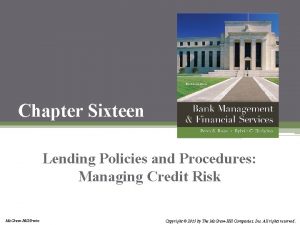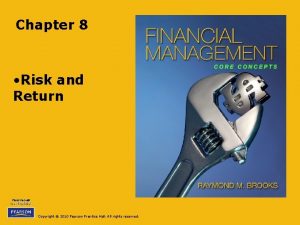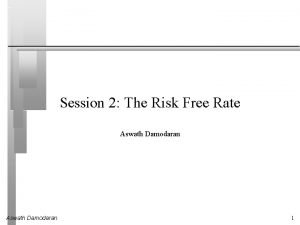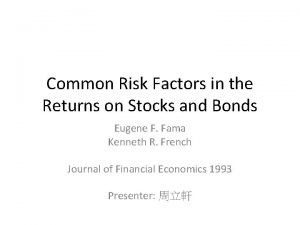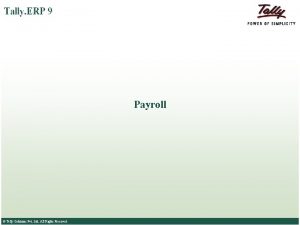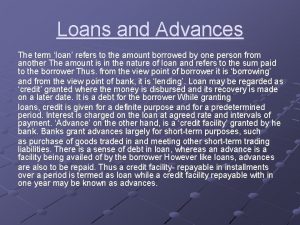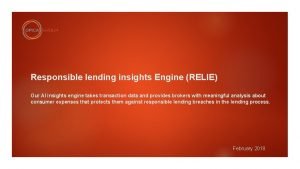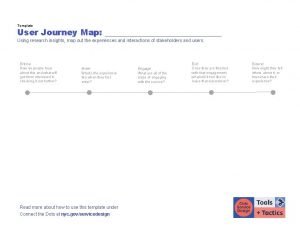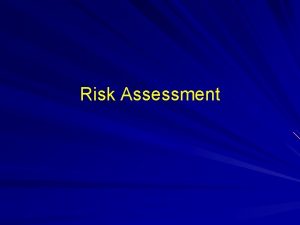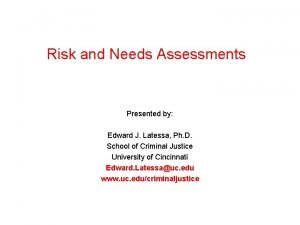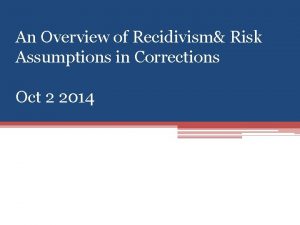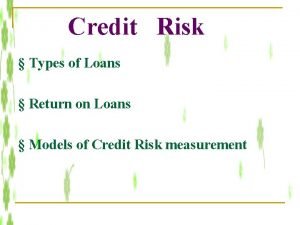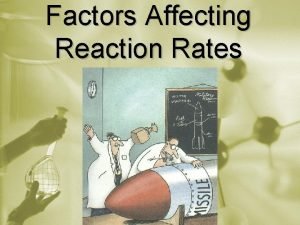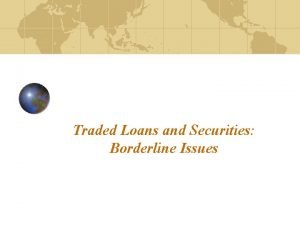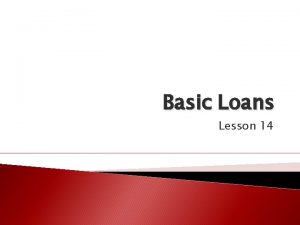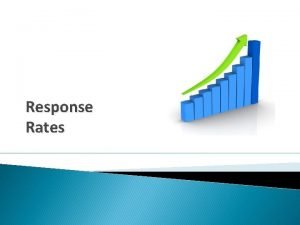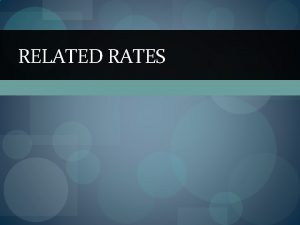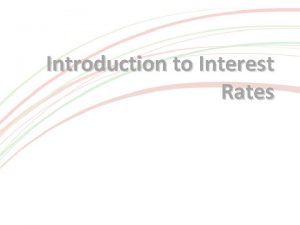Risk factors in loans and lending rates Lending
































































- Slides: 64

Risk factors in loans and lending rates

Lending rate • Lending rate is the main reflection of loan risk. • How do banks determine lending rate?

Central bank discount rates • The discussion of lending rates helps us understand the practice of commercial banks. It also helps us understand the policies of the central banks. • Discount rates of the central banks are the lending rates of the central governments. • Discount rate is the main tool governments and central banks use to fine tune economic activities.

Risk Factors • We will examine some risk factors that affect loan rate. – Salvage ratio – Ratio of self funding – Uncertainty – Project duration – Diversification

Return on Asset in Financial Institutions • Jan 2018, Bank of Canada overnight rate, • • • 1. 25%, Prime rate from major Canadian banks, 3. 45% The rate differential between prime rate and Bank of Canada overnight rate is 220 basis point. This is a rough approximation of Ro. A in financial institutions. More info on prime rate: https: //www. ratehub. ca/prime-rate

Comments • Rate of return on financial assets, at around 200 basis points, are very low. • This is because financial transactions are very simple. They usually can’t earn high returns. • Banks have two ways to earn high return on capital.

• First, banks can increase leverage ratio. • This is the traditional method. • More recently, banks securitize their assets, such as mortgages and sell them to third parties. • They can continue to earn incomes from managing these assets. • But they pass the risks to third parties.

Salvage ratio and loan rate • Different businesses and different types of loans have different salvage ratios. • Real estate mortgages usually have high salvage ratios. • High tech companies usually have low salvage ratios. • How salvage ratios affect loan rates?

Example 1 • Banks charge interest rate based on risk of loans. Assume the bank’s borrowing rate is 1% per annum. A business applies for 1 million loan for a project and plans to repay the loan in one year. A loan officer estimates the payoff from the project will be 2 million with 85% probability and 0. 8 million with 15% probability. If a loan defaults, on average, a bank can get 60% of the salvage value. If the bank requires 2% return on its loans, what would be the loan rate?

Solution • If the project payment is 0. 8 million, the company will declare bankruptcy and the bank will receive • 0. 8*0. 6 = 0. 48 million • If the project payment is 2 million and the loan rate is x, the bank will receive • 1+x million

• Overall, the bank is expected to receive • (1+x)*0. 85+0. 48*0. 15 = 1+1%+2% • 1% is the bank’s cost of borrowing. 2% is the bank’s required rate of return on its loans • Solving the equation to get • X = 12. 71% • Discount rate is a reflection of downward risk

Discussion • If the salvage ratio is increased to 80%, the interest rate will decline to 9. 88%. • When the salvage ratio is higher, the loan rate is lower. • If the credit and judicial systems can increase the ratio of salvage value, the loan rate will decline.

Judicial systems and salvage ratio • In US and Canada, Chapter 11 Bankruptcy Code and CCAA (Companies Creditors Arrangement Act) allow debtors to stop interest payment while restructuring their businesses. • In continental Europe, when debtors could not pay out interests, creditors can take over the assets swiftly. This often increases the salvage ratio.

• The differences in judicial systems reflect the differences of abundance of resources. • In resource rich societies, such as North America, there are more opportunities to turn around businesses. Judicial systems give businesses more chances. • In resource poor societies, there are less opportunities. Judicial systems act swiftly to reduce further waste.

Bonds and Stocks • Bond owners have higher priority in claiming assets over stock owners. Bonds have higher salvage values than stocks. • This is one reason cash flows from bonds are discounted at lower rates than cash flows from stocks.

Financing choice: Debt or equity • For a high risk project, debt financing will incur high interest rate. We generally choose equity financing. • In general, low risk projects use debt financing, high risk projects use equity financing. • Some projects use the mix of debt and equity financing. Low risk tranche use debt financing and high risk tranche use equity financing.

General principle • Type of financing should match type of project cashflows. • Less variable project cashflows should use debt financing. This will lower the payment rate with interests. • More variable project cashflows should use equity financing. This allows more flexible payments with dividends.

Ratio of self funding and loan rate • Some companies or investment projects fund more with their own money. Some with less their own money. • How does the ratio of self funding affect loan rate?

Example 2 • A business plans for a project, which will require 1 million initial investment. The business will supply 0. 1 million funding itself. It will apply for 0. 9 million loan from a bank and plans to repay the loan in one year. A loan officer estimates the payoff from the project will be 1. 3 million with 85% probability and 0. 7 million with 15% probability. If a loan defaults, on average, the bank can get 60% of the salvage value. Assume the risk free rate is zero.

• If the bank requires 2% return on its loans, what would be the loan rate? If the business will supply 0. 2, 0. 3 million funding itself and apply a loan for the remaining amount of capital, what will be the loan rates? What conclusion you can draw?

Solution • The amount of loan • 0. 9 million • The required payback • 0. 9*1. 02= 0. 918 • Assume the loan rate is x • 0. 9*(1+x)*0. 85+0. 7*0. 6*0. 15=0. 918 • Solving the equation to obtain x • X = 11. 76%

• When the part of self funding is 0. 2 million or 0. 3 million, the required loan rate is 10. 74% or 9. 41%. • This shows that the higher the percentage of self funding, the lower the loan rate. • When you put in more of your own money, others trust you more.

Discussion • How much trading in banks is funded by traders themselves or by banks? • Most of the trading in banks are not backed by their own money. Instead, they are backed by the understanding that the governments will help out in case of insolvency. • Should banks enjoy such low rate in their own trading activities?

Discussion (Continued) • It is often said the causes of financial crisis are “complex”. Are they really that complex? • They are not complex. • Tradings with high leverage are pursued because upside goes to participants and downside goes to the public.

Projects with different length • In earlier examples, we assume project duration is one year. • Project length may be different from one year. • We can perform the same calculation.

Example 3 • A business plans for a natural gas project, which will require 40 million initial investment. The business will supply 8 million funding itself. It will apply for 32 million dollar loan from a bank and plan to repay the loan in two years. A loan officer estimates the payoff from the project will be 80 million with 90% probability and 24 million with 10% probability, depending on future natural gas prices. If a loan defaults, on average, a bank can get 70% of the salvage value. Assume the bank’s financing cost is 2% per annum.

• If the bank requires 2. 5% per annum return on its loans, what would be the loan rate? If the business will supply 16 million funding itself and apply a loan for the remaining amount of capital, what will be the loan rate? What conclusion you can draw?

Solution • 0. 9*32*(1+x)^2+0. 1*24*0. 7 • =32*(1+2%+2. 5%)^2

amount of initial investment 40 million self funded part 8 16 amount of loan 32 24 2. 00% risk free rate probability 0. 9 0. 1 expected payoff 80 24 Average payback to bank salvage ratio required return on loans required payback loan rate 34. 94 26. 21 70% 2. 50% 34. 95 26. 21 7. 47% 6. 56%

Uncertainty and discounting • Different investment projects have different levels of uncertainty. • How does this difference affect the loan rate?

Example 4 • There are two projects. Each require 1 million dollar funding. Each project will be liquidated in one year’s time. There is a 60% probability that the liquidation value will be exp(S) and a 40% probability that the liquidation value will be exp(-S). Where S =0. 3 for the first project and S =0. 4 for the second project.

• Suppose both projects are 20% self funded and need to take 80% loan from a bank. Assume the bank’s funding cost is 3%. The required rate of return on its loans is 2%. When the project could not make loan payment in full, the bank will take over the asset of the project. What are the loan rates for the two projects?

Solution • The amount of loan is 0. 8 • When the project performs well, the company will payback principal and interest. When the project performs poorly, the bank gets the salvage value. • For the first project • 0. 6*0. 8*(1+x) +0. 4*exp(-0. 3) =0. 8*(1+3%+2%) • X = 13. 27%

• Similarly, for the second project, the loan rate is 19. 14%. • Projects with higher uncertainty are charged with higher loan rate.

• In the next example, we will discuss the relation between uncertainty and discount rate from another perspective.

Example 5 A company has a choice to select one of the two projects. The first project requires an initial spending of 10 million dollars. For the next ten years, the project will generate 3 million dollar profit each year. The second project requires an initial spending of 20 million dollars. The project will generate 3 million dollar profit the first year. The profit from the project will increase 10% from each previous year. The project will last ten years. The criterion of selection is NPV of a project.

• If the discount rate is 3%, which project you will choose? If projects are forced to close down after three years due to unexpected circumstances, what would be the realized value for both projects, discounted at 3%? If the discount rate is 10%, which project you will choose? With the benefit of hindsight, what discount rate one should use to value two potential projects? How should the choice of discount rate be related to uncertainty and our capacity in information processing?

Solution •

Solution (Continued) • Choose project 2

Solution (Continued) •

Solution (Continued) • The second project causes bigger losses.

Solution (Continued) •


Discussion • Some people claim that since future is unpredictable, one should not be held responsible for losses due to uncertainty. • However, if we acknowledge future is highly uncertain, we should discount future at a higher rate. This will help us reduce the amount of losses due to uncertainty. • Policymakers often attribute bad economic performance to uncertainty but at the same time lower the discount rate. Are they being consistent?

Project duration and discounting • Some projects last longer than others. • How project duration affects loan rate?

Example 6 • There are two projects. Each require 1 million dollar funding. Project one will be liquidated in one year’s time. There is a 60% probability that the end value will be exp(S) and a 40% probability that the end value will be exp(-S), where S =0. 3. Project two will be liquidated in two year’s time. There is a 60% probability that the end value will be exp(2*S) and a 40% probability that the end value will be exp(-2*S), where S =0. 3.

• Suppose both projects are 20% self funded and need to take 80% loan from a bank. Assume the bank’s funding cost is 3%. The required rate of return on its loans is 2%. When the project could not make loan payment in full, the bank will take over the asset of the project. What are the loan rates for the two projects?

Solution • The amount of loan for both projects is 0. 8 million. • For the first project • 0. 6*0. 8*(1+x) +0. 4*exp(-0. 3) =0. 8*(1+3%+2%) • X = 13. 27% • For the second project, • 0. 6*0. 8*(1+y)^2 +0. 4*exp(-2*0. 3) =0. 8*(1+3%+2%)^2 • Y = 17. 48%

• Projects with longer duration are charged with higher loan rate. • In general, term structure of interest rate curves upward. Interest rates for longer terms are higher.

How loan diversification affect loan rates? • In security investment, diversification reduces risk. • Does diversification in loans reduce risk as well?

Example 7 • Assume the bank’s borrowing rate is 2% per annum. A business applies for 15 million loan for a project and plans to repay the loan in one year. A loan officer estimates the payoff from the project will be 30 million with 80% probability and 10 million with 20% probability. If a loan defaults, on average, a bank can get 70% of the salvage value. If the bank requires 3% return on its loans, what would be the loan rate?

Solution • Suppose the loan rate is x. If the project is doing well, the bank will be paid back full loan with interest. If the project is doing badly, the bank will receive the salvage value. • Overall, the bank is expected to receive • 15(1+x)*0. 8+10*0. 7*0. 2 = 15*(1+2%+3%) • 2% is the bank’s cost of borrowing. 3% is the bank’s required rate of return on its loans • Solving the equation to get • X = 19. 6%

Example 8: Loan to two projects • Now a company is planning two projects. Each project has the same payoff profile as the previous example. First assume the payoff of the two projects are independent. The distribution of the total payoff will be 60 (64%) 40 40 20 (4%) (16%) • The numbers in the parentheses are probabilities corresponding to the particular payoff

Solution • Two projects will need a total loan of 15*2 = 30 million loan. • Assume the loan rate is x. If both or one project is doing well, the bank will be paid back full loan with interest. If both projects are doing badly, the bank will receive the salvage value.

• Overall, the bank is expected to receive • 30(1+x)*0. 64+30(1+x)*0. 32+20*0. 7*0. 04 = 30*(1+2%+3%) • Solving the equation to get • X = 7. 4% • This is much lower than the loan rate on one project.

Example 9: Loan to two projects, Further discussion • However, most of the time, project payoffs are correlated for they are influenced by many common factors, such as general economic environment and the firm’s internal environment. Next we assume the payoff of the two projects are positively correlated. Assume the distribution of the total payoff is 60 (70%) 40 40 20 (10%) • The numbers in the parentheses are probabilities corresponding to the particular payoff

Solution • In this case, the bank is expected to receive • 30(1+x)*0. 7+30(1+x)*0. 2+20*0. 7*0. 1 = 30*(1+2%+3%) • Solving the equation to get • X = 11. 5% • This is lower than the loan rate on one project, but higher than on two independent projects.

Discussion • Diversified projects can reduce risk and hence reduce loan rates. • Large companies often get lower rate financing. They are more diversified. • Governments, as the most diversified institutions, generally have the lowest financing rate.

• From financial perspective, there are incentives for companies to grow larger, for governments to pick up more services. • BC Hydro was established as a crown corporation to replace a private firm to lower financing cost before Bennett Dam was built.

• Similarly, banks prefer to grow larger through mergers. • Then Liberal finance minister Paul Martin rejected two huge mergers in the late 1990 s – RBC with BMO, and CIBC with TD.

• Why the government blocked the proposed mergers? • To further reduce number of the banks will give banks too much power. • In general, larger institutions will be more rigid. They become difficult to adapt to big changes.

• In living systems, large organisms can withstand environmental variation better than small organisms. They generally have more fat reserves. Large companies often have more cash reserves as well. • But large organisms are less adaptable to really big changes. It is more difficult for large companies to change their structures.

Discounting, long term forecasting and fraud • Low discount rate makes expected earning in distant future more valuable. This encourages long term forecasting. • Since we are less capable to forecast distant future, aggressive optimism and downright fraud often flourish in low discount rate environment.

Summary • Loan rates reflect the downside risk of investment projects.
 Life below zero: bank lending under negative policy rates
Life below zero: bank lending under negative policy rates Unit rate
Unit rate Equivalent ratios
Equivalent ratios Ratios rates and unit rates
Ratios rates and unit rates Ratios rates and unit rates
Ratios rates and unit rates Lending policies and procedures managing credit risk
Lending policies and procedures managing credit risk Liquidity measures
Liquidity measures Chapter 8 risk and rates of return problem solutions
Chapter 8 risk and rates of return problem solutions Default spread risk free rate
Default spread risk free rate Residual risk and secondary risk pmp
Residual risk and secondary risk pmp Business risk and financial risk leverage
Business risk and financial risk leverage Attributable risk formula
Attributable risk formula Relative risk calculation
Relative risk calculation Common risk factors in the returns on stocks and bonds
Common risk factors in the returns on stocks and bonds Risk factors of head and neck cancer
Risk factors of head and neck cancer Abiotic factors and biotic factors
Abiotic factors and biotic factors Abiotic factors and biotic factors
Abiotic factors and biotic factors Abiotic vs biotic factors
Abiotic vs biotic factors Factors of 49
Factors of 49 Factors of 7
Factors of 7 Factors of 8 and 24
Factors of 8 and 24 Payroll in tally
Payroll in tally Loan vocabulary
Loan vocabulary Short term loans and advances
Short term loans and advances Relie responsible lending and insights engine
Relie responsible lending and insights engine An institution for receiving keeping and lending money
An institution for receiving keeping and lending money Securities lending and borrowing example
Securities lending and borrowing example Queensbridge map
Queensbridge map Relie responsible lending and insights engine
Relie responsible lending and insights engine Relie responsible lending and insights engine
Relie responsible lending and insights engine Relie responsible lending and insights engine
Relie responsible lending and insights engine Relie responsible lending and insights engine
Relie responsible lending and insights engine Draw rmmm plan
Draw rmmm plan Risk reduction vs risk avoidance
Risk reduction vs risk avoidance Relative risk calculation
Relative risk calculation Inherent risks examples
Inherent risks examples Absolute risk vs relative risk
Absolute risk vs relative risk Activity sheet 2 stock market calculations answer key
Activity sheet 2 stock market calculations answer key Risk classification
Risk classification Pembiayaan risiko (risk financing)
Pembiayaan risiko (risk financing) The biggest risk is not taking any risks
The biggest risk is not taking any risks Key risk indicators for vendor management
Key risk indicators for vendor management Business risk audit
Business risk audit Risk map risk management
Risk map risk management Low sodium symptoms
Low sodium symptoms Dynamic risk factors
Dynamic risk factors Distributive shock
Distributive shock Central eight risk factors
Central eight risk factors What are examples of risk factors?
What are examples of risk factors? Dynamic risk factors
Dynamic risk factors Risk factors for cephalopelvic disproportion
Risk factors for cephalopelvic disproportion Central eight risk factors
Central eight risk factors Carotonemia
Carotonemia Osmotic demyelination syndrome risk factors
Osmotic demyelination syndrome risk factors Modifiable risk factors for hypertension
Modifiable risk factors for hypertension Hiv risk factors
Hiv risk factors Acsm risk factors
Acsm risk factors Open angle glaucoma risk factors
Open angle glaucoma risk factors 5 ps formulation
5 ps formulation Central eight risk factors
Central eight risk factors Latent phase of labor
Latent phase of labor Factors affecting business risk
Factors affecting business risk Dvt risk factors
Dvt risk factors Dvt risk factors
Dvt risk factors Pancreatic carcinoma risk factors
Pancreatic carcinoma risk factors





